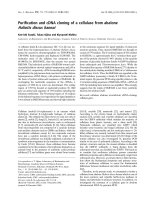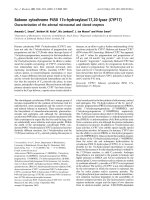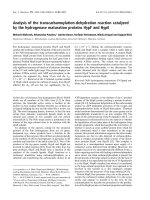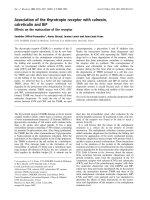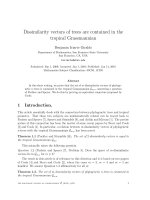20 gonad maturation of the tropical abalone haliotis
Bạn đang xem bản rút gọn của tài liệu. Xem và tải ngay bản đầy đủ của tài liệu tại đây (1.18 MB, 8 trang )
Seediscussions,stats,andauthorprofilesforthispublicationat: />
Gonadmaturationofthetropicalabalone
HaliotisvariaLinnaeus1758(Vetigastropoda:
Haliotidae)
ArticleinMolluscanResearch·October2007
CITATIONS
READS
5
118
1author:
TheparambilMohamedNajmudeen
CentralMarineFisheriesResearchInstitute
18PUBLICATIONS82CITATIONS
SEEPROFILE
AllcontentfollowingthispagewasuploadedbyTheparambilMohamedNajmudeenon17August2016.
Theuserhasrequestedenhancementofthedownloadedfile.Allin-textreferencesunderlinedinblueareaddedtotheoriginaldocument
andarelinkedtopublicationsonResearchGate,lettingyouaccessandreadthemimmediately.
Molluscan Research 27(3): 140–146
/>
ISSN 1323-5818
Magnolia Press
Gonad maturation of the tropical abalone Haliotis varia Linnaeus 1758
(Vetigastropoda: Haliotidae)
T. M. NAJMUDEEN
Department of Marine Biology, Microbiology and Biochemistry, School of Ocean Science and Technology, Cochin University of Science and
Technology, Cochin-16, India, Email:
Abstract
Gonad development of the tropical abalone Haliotis varia Linnaeus, 1758 from the Gulf of Mannar, southeast coast of India,
was studied through the observation of gonad histology and analysis of gonadosomatic index. The sequence of gametogenesis
was similar to previously described tropical haliotids. Gonad maturation stages were assigned to six categories and the details
of different stages documented. Pre-vitellogenic oocytes were abundant in the early and late maturing ovary and were attached
to the connective tissue tubules by their stalks. Vitellogenesis began when the primary oocytes reached 50 µm in diameter culminating in ripe oocytes of 180 ± 20 µm in diameter. All six gonad maturity stages were observed during the 14-month study
period suggesting that gametogenesis was continuous throughout the year. The breeding season extended from December to
February with asynchronous gonad development. Since active gametogenesis in this species was observed in all months,
mature specimens could be produced throughout the year by induced maturation which would facilitate hatchery production.
Key words: gonadosomatic index, gonad histology, annual reproductive cycle, maturity stages, vitellogenic oocytes, Gulf of
Mannar, gametogenesis.
Introduction
All tropical maritime countries involved with abalone
fisheries have intensified abalone research owing to the
rising demand for cocktail size, live tropical abalone in the
international market (Chen 1989, Guo et al. 1999). Haliotis
varia Linnaeus, 1758 has a limited distribution along the
Indian coast and in some other Southeast Asian countries.
Even though H. varia does not support any commercial
fishery in India, the successful accomplishment of hatchery
seed production of this species has opened new avenues in
the field of abalone mariculture in the country (Najmudeen
and Victor 2004a). Preliminary studies on the reproduction
and juvenile production of H. varia have been carried out in
recent years to elucidate its mariculture prospects
(Najmudeen 2000, Najmudeen et al., 2000, Najmudeen and
Victor 2004a, b). In India, H. varia is distributed in the Gulf
of Mannar, and Andaman and Nicobar Islands.
The developmental changes occurring in the germ cells
of molluscs during gametogenesis have received
considerable attention. Knowledge of the breeding seasons
and gonad maturation process are vital in attempting captive
breeding and induced maturation of cultured species. Gonad
maturation stages of nearly all the commercially important
temperate (e.g., Hayashi 1980, Wells and Kiesing 1989,
Bang and Hahn 1993, McShane and Naylor 1996, Wood and
Buxton 1996) as well as tropical (e.g., Liu et al. 1987,
Jarayaband et al. 1994, Apisawetakan et al. 1997, Minh
1998, Capinpin et al. 1998, Jebreen et al. 2000, Counihan et
al. 2001) abalone species have been studied and documented
except that of Haliotis varia. Investigation of the gonad
maturation process and thereby the reproductive potential of
the valuable abalone resource in tropical Indo-Pacific
countries may help to establish aquaculture production. The
purpose of the present investigation is to describe the
reproductive changes taking place within the ovary and testis
140
of H. varia in relation to gonad maturation and to find out its
peak breeding period along Indian coastal waters.
Materials and Methods
Collection of samples: Samples of Haliotis varia were
collected monthly from the intertidal rocks at Tuticorin
Harbour basin of the Gulf of Mannar (08° 45’ N 78° 12’ E),
on the southeast coast of India from January 1998 to
February 1999. Here H. varia was distributed at a depth
range of 1–3 meters. Each month, 30 specimens were
shucked and dissected to examine the gonad and maturity
condition. The soft body weight, digestive gland weight and
gonad weight were taken on a wet weight basis.
Gonad histology: Gonads collected from H. varia were
processed for histological assessment of gametogenesis. At
each sampling, ten abalone were selected at random. Their
conical appendages containing the gonad and underlying
digestive gland were excised half way along their length and
fixed in 10% neutral buffered formalin for 24 hours, then
stored in 70% ethanol. Fixed conical appendage pieces were
dehydrated in ascending grades of ethanol, cleared in xylene
and embedded in paraffin. Sections (7 µm) were stained with
Harri’s haematoxylin (Preece 1972) and eosin. The best
slides were analysed and photographed.
Gonadosomatic index (GSI): The use of a gonad index
as a measure of the reproductive cycle is based on the
assumption that maturation and breeding coincide with
maximum gonad weight (LeBour 1938). The gonadosomatic
index (GSI) for each abalone was calculated using the
formula, GSI = (wet weight of gonad in grams/soft body
weight of abalone in grams) x 100 (Webber and Giese 1969).
Differences in GSI for males, females and pooled sexes over
time were compared using two factor analysis of variance
(ANOVA) (Snedecor and Cochran 1967).
COPYRIGHT © 2007 MALACOLOGICAL SOCIETY OF AUSTRALASIA
GONAD MATURATION OF HALIOTIS VARIA
In addition to variation in gonad indices, the annual
reproductive cycle of Haliotis varia was determined by
recording the relative abundance of different gonad maturity
stages each month during the study.
Results
Morphological and cellular events of gametogenesis
The germinal epithelium in the gonad of Haliotis varia
was supported by connective tissue tubules that run
perpendicular to the outer gonad wall. The testis
development was classified based on the presence and
relative distribution of spermatogonia, spermatocytes,
spermatids and spermatozoa within the testis lumen as well
as around the connective tissue tubules. The spermatogonia
were approximately 5.33 ± 0.65µm in diameter, and
developed into primary and secondary spermatocytes of 4.00
to 4.23 µm diameter and highly basophilic spermatids of
between 1.23 and 3.43 µm in diameter. The spermatozoa
consisted of an anterior oesnophilic conical acrosome
followed by a posterior barrel-shaped basophilic nucleus of
2.80 ± 0.7 µm in length. When fully mature, the whole testis
lumen was packed with mature spermatozoa.
Pre-vitellogenic and early-vitellogenic oocytes were
found clumped together in the developing ovary of H. varia.
The pre-vitellogenic oocytes were basophilic, less than 50
µm in diameter and had a prominent spherical nucleus.
Vitellogenic oocytes were classified into early-vitellogenic
and late-vitellogenic oocytes. The former were 50–120 µm
in diameter, moderately oesnophilic and with a clear nucleus.
The latter were 120–200 µm in diameter, strongly
oesnophilic and polygonal in shape. The process of
vitellogenesis started when the primary oocytes reached 50
µm in diameter. Ripe ovaries were exclusively filled with
vitellogenic oocytes.
The sex and the stage of maturity of H. varia could be
identified by pulling back the foot tissue using forceps. Ripe
gonads constituted about 15% of the soft body weight. Based
on the size, shape, colour and texture of the gonad and its
microscopic structure through histological examination,
testes and ovaries at different stages of maturity were placed
into six categories: early maturing/ recovering, late maturing,
ripe, partially spawned, spent and immature stages. These
stages were used to describe the histology of
spermatogenesis and oogenesis.
Stage I: Early maturing/ recovering: The testis was
flaccid, pale orange in colour and comprised only 40% of the
conical appendage. In cross-section, it appeared as a thin
sheath over the thick digestive gland (Fig. 1A). The lumen of
the testis was traversed by branching tubes of connective
tissue and mainly contained spermatogonial cells and
spermatocytes. Spermatogonia and primary spermatocytes
were characterised by an oval nucleus, while secondary
spermatocytes had a more or less round nucleus. The ovary
appeared as a thin flabby, grayish sheath and comprised 40%
of the conical appendage. Early-vitellogenic oocytes, about
45 µm in diameter, were seen attached to the follicle cells by
141
a stalk (Fig. 2A). The oocytes under magnification appeared
round, sometimes irregular and transparent. These had well
defined oolemmae and prominent nuclei, and had not yet
filled with yolk.
Stage II: Late maturing: Testis was thicker and bright
orange in colour and comprised about 60% of the conical
appendage. It contained large numbers of spermatocytes and
spermatids (Fig. 1B). Few sperm were seen with their tails
facing towards the digestive gland. The spermatocytes were
abundant near the walls of the testis and around the tubules
(Fig. 1C). Highly basophilic spermatids were also present in
the testis lumen. The ovary became bluish in colour and
appeared as a thick sheath over the digestive gland. Many
large vitellogenic cells, approximately 68 ± 5 µm in diameter
could be seen (Fig 2B), mostly attached to the trabeculae by
stalks and oriented towards the digestive gland.
Stage III: Ripe: The testis was turgid, cylindrical and
bright cream in colour and comprised 80–90% of the conical
appendage. Little or no digestive gland area could be seen in
the cross section of the conical appendage. Many radially
arranged spermatozoa with their tails facing the digestive
gland area were seen in the ripe testis section (Fig. 1D, E).
Mature spermatozoan measured 2.8 ± 0.7 µm in length. The
ovary was blue or bluish green in colour, massive and turgid
with little or no digestive gland area in the cross-section of
the conical appendage. The gonad covered about 80% of the
conical appendage and became more cylindrical. The lumen
of the ovary was filled with large number of late vitellogenic
oocytes, which measured 180±20 µm in diameter (Fig. 2C).
Most of the eggs were polygonal in shape, with a distinct
nucleus and a round nucleolus (Fig. 2D). Oocytes closer to
the periphery of the ovary were predominantly attached to
the trabeculae, while the detached oocytes appeared to be
undergoing maturation or ready for spawning.
Stage IV: Partially spawned: The testis was bright
cream, flaccid, loose in appearance and comprised about
80% of the conical appendage. Some spermatogonial cells
and spermatocytes appeared in the periphery of the testis
(Fig. 1F). Phagocytes were present in the inter trabecular
spaces. The ovary is flabby, thick, and bluish and comprised
80% of the conical appendage. In the lumen near the
digestive gland, the eggs were fewer in number, compared to
the ripe ovary (Fig. 2E). Some oocytes could be seen in a
state of reabsorption. The oocyte diameters ranged between
140 and 228 µm.
Stage V: Spent: The testis was a thin gray sheath
covering the digestive gland. The relative area of the
digestive gland was larger than in stage IV in cross-section.
Relatively few darkly stained sperm occurred within the
lumen, apparently a residue from the previous spawning. The
connective tissue tubes were more convoluted due to the
collapsed testis (Fig. 1G). The ovary was highly shrunken
and collapsed. It enclosed the digestive gland as a thin
translucent and flaccid sheath, loosely packed with some
primary oocytes. The trabeculae were emaciated due to the
collapsed state of the lumen (Fig. 2F). Lacunae were present
in the trabeculae and a few opaque, largely disintegrated
oocytes were observed.
142
NAJMUDEEN (2007) MOLLUSCAN RESEARCH, VOL. 27
FIGURE 1. Light micrographs showing histological sections of the testes of H. varia. A Cross-section through an early maturing testis
showing growing spermatogonia along the connective tissue tubules (CT). Gonad (G) forms a sheath over the digestive gland (DG) B Late
maturing stage with more spermatocytes (SC) C Enlarged view of late maturing testis showing cluster of spermatogonial cells (SG) around
the connective tissue tubule D Ripe testis filled with radially arranged spermatozoa (SP) around the connective tissue tubules E Enlarged
view of ripe testis with spermatozoa F Partially spawned testis showing collapsed trabeculae (TB) G Spent testis with residual spermatozoa
and enlarged trabeculae H Cross-section through an indeterminate stage gonad with very little gonad area (G) compared to the digestive
gland area (DG) in the conical appendage. Scale bars: A, B, C, D, G, H = 80 µm; C, E = 20 µm
GONAD MATURATION OF HALIOTIS VARIA
143
FIGURE 2. Light micrographs showing histological sections of the ovaries of H. varia. A Cross-section through the early maturing ovary
with proliferating primary oocytes (PO) along the connective tissue tubules (TB) B Late maturing ovary with early vitellogenic oocytes
(VO), OW- ovarian wall C Ripe female gonad with tightly packed oocytes (RO) having a prominent nucleus (N) D Enlarged view of the
ripe oocyte with clear nucleus (N) and well developed nucleolus (NL) and filled with yolk granules (Y) in the cytoplasm E Partially
spawned ovary with loosely packed unspawned ripe oocytes (RO) in the ovarian lumen (OL). Note the spaces vacated by partial spawning
F Spent ovary with collapsed trabeculae, and some unspawned oocytes (UO). Scale bars: A, F = 80 µm; B, D = 40 µm; C, E = 200 µm.
Stage VI: Indeterminate: This stage was common for
both male and female individuals. The gonad was
indistinguishable even in histological examination. The
gonad was a dark, grayish thin sheath comprising 30% of the
conical appendage. The gonad lumen was almost filled with
branches of trabeculae, which were attached to both the outer
gonadal wall and the digestive gland (Fig. 1H).
Gametogenic cycle
The gametogenic cycle of Haliotis varia at the study
area showed a distinct temporal pattern in the relative
abundance of the different gonad maturity stages (Fig. 3).
Almost all the gonad maturity stages were present in each
month throughout the year. Early maturing/ recovering
gonads were present in high numbers for the six months of
the year from June to October, indicating active
gametogenesis. Partially spawned gonads were 33% of the
September sample demonstrating some spawning mainly by
males. In December, the number of partially spawned and
spent stage gonads increased (69%), indicating the main
144
onset of spawning. The percentage of ripe specimens was
highest in February (88%) and in January (81%). In February
1999, all the females sampled were ripe, this period
representing the active breeding season. Some animals
showed immediate recovery after spawning (25%) in March.
The GSI values varied significantly between months
throughout the study period. The highest GSIs were observed
in January 1999 followed by February 1999 and February
1998. High values were maintained from January to April
NAJMUDEEN (2007) MOLLUSCAN RESEARCH, VOL. 27
(Fig. 4). A gradual decrease was evident from March to June,
which indicated the completion of most spawning in March.
The lowest GSIs were in August 1998 and October 1998.
The standard deviation for the monthly values of GSI was
high, indicating asynchronous spawning behaviour between
individuals.
FIGURE 3. Annual gametogenic cycle of H. varia in the Gulf of Mannar. Histograms show the relative abundance of different maturity
stages of the gonad.
FIGURE 4. Reproductive cycle of H. varia in the Gulf of Mannar from January 1998 to February 1999. Mean GSI (±SD) for male and
female.
145
GONAD MATURATION OF HALIOTIS VARIA
Discussion
Different criteria such as percentage of gonad covering the
digestive gland, colour and shape of gonad, gonadosomatic
index and ova diameter have been employed by various
workers in order to classify the stages of maturity for abalone
(Tomita 1967, Giorgi and DeMartini 1977, Ault 1985). In the
present study, the ovary and testis of Haliotis varia were
classified into six stages based on all the above-mentioned
criteria. This was similar to the classification used by Wood
and Buxton (1996) for H. midae Linnaeus, 1758. The
sequence of gametogenesis was similar to those described
for other tropical haliotids (Apisawetakan et al. 1997, Minh
1998, Capinpin et al. 1998, Jebreen et al. 2000, Counihan et
al. 2001), except in the number of maturity stages assigned.
Oogenesis started with primary germ cells that developed
through several vitellogenic stages, and finally to ova.
Spermatogenesis commenced with the formation of
spermatogonial cells from the germinal epithelium and
proceeded with various cell types to mature sperm (Webber
and Giese 1969, Jebreen et al. 2000). In H. varia, the early
vitellogenic oocytes measured about 50 µm in diameter. In
H. midae also, vitellogenesis started when the oocytes had a
diameter of 50 µm (Newman 1967, Wood and Buxton 1996).
In most broadcast fertilisers, after spawning, the gonad
enters a 'resting stage' in which gametes are absent
(Loosanoff 1962). Temperate species, in particular, show the
resting phase in winter, when gametogenic activity is
suspended (Giese and Pearse 1977). However, a period of
gonad quiescence has not been reported in some other
temperate species like H. cracherodii (Webber and Giese
1969). For H. varia, a resting phase was found but only for a
short period and immediately after that gametogenesis was
initiated.
The reproductive cycle is reflected by prominent
changes in gonad size. The monthly variation in GSI has
frequently been used in species with gonads that are easy to
separate from the rest of the soma (Grant and Tyler 1983). In
Haliotis cracherodii Leach, 1814. Webber and Giese (1969)
calculated the GSI as the weight of gonad relative to the
weight of the soft body parts. Boolootian et al. (1962) found
that monthly samples of gonad indices of black abalone
showed seasonal variations in the Pacific Grove area of
California. High values coincided with the breeding season.
Temperate species of abalones generally have distinct annual
spawning seasons, with some spawning once or twice a year,
whereas tropical species appear capable of spawning all year
round (Singhagraiwan and Doi 1992, Jarayabhand and
Paphavasit 1996). In the present study, H. varia appeared
capable of spawning in most months of the year. Though
continuous gonad development was observed year round, the
peak spawning period was restricted to three to four months
in a year. Bussarawit et al. (1990) suggested that there was a
greater gametogenic activity in tropical than in temperate
species, based on their observations of a rapid post spawning
recovery in H. varia at Phuket, Thailand. The continuous
presence of ripe gametes in both the sexes and the ability to
reproduce at any time of the year is unusual for the majority
of the temperate abalone species. Webber and Giese (1969)
reported that H. cracherodii spawned only during a six week
period during the year. However, some temperate abalones
are also capable of spawning throughout the year, e.g., the
temperate Australian H. roei Gray, 1826 (Shepherd and Laws
1974). The presence of ripe males in most of the months was
evident in H. varia during the present investigation.
According to Martel et al. (1986), some marine gastropod
species have a completely inverse timing in the development
of the testis and ovary. However, such separated periods of
spermatogenesis and oogenesis were not found in this study
of H. varia. As noted by Capinpin et al. (1998) in H. asinina
Linnaeus, 1758, the ranges of GSI were broad, indicating
asynchronous spawning by the individuals. Similar
observations were made in the trochid Trochus niloticus
Linnaeus, 1758 by Hahn (1993).
As maturation of gametes in molluscs is reported to be
initiated by annual temperature fluctuations (e.g., Fretter and
Graham 1964), it should be possible to obtain mature
Haliotis varia throughout the year in the laboratory by
regulating temperature with an adequate supply of algal
food. Induced maturation of many commercially important
bivalve species has been achieved in India by using the
above techniques (Pillai et al. 2001). Since spawning
inducement and juvenile production in this species have been
achieved in controlled conditions (Najmudeen and Victor
2004a), the availability of ripe individuals throughout the
year would facilitate the establishment of abalone hatchery
operations to augment production through aquaculture.
Acknowledgements
I thank the Director, Central Marine Fisheries Research
Institute, Cochin for providing necessary facilities. Thanks
are also due to the SCUBA divers at the Tuticorin and
Mandapam research centres of CMFRI, who helped me
during the collection of the abalone used in this study, and
Dr. A.C.C. Victor, former Principal Scientist, CMFRI for his
guidance in conducting the work. I also thank the two
anonymous reviewers and the editor, Dr. Winston Ponder, for
their valuable suggestions and critical comments, which
helped to improve the manuscript. The study was financed
by the Indian Council of Agricultural Research, New Delhi.
References
Apisawetakan, S., Thongkukiatkul, A., Wanichanon, C., Linthong,
V., Kruatrachue, M., Upatham, P.S., Poonthong, T. & Sobhon, P.
(1997). The gametogenic processes in a tropical abalone
Haliotis asinina Linnaeus. Journal of the Science Society of
Thailand 23, 225–240.
Ault, J. (1985). Some quantitative aspects of reproduction and
growth of the red abalone, Haliotis rufescens Swainson. Journal
of the World Mariculture Society 16, 398–425.
Bang, K.S. & Hahn, S.J. (1993). Influence of water temperature on
the spawning and development of the abalone, Sulculus
diversicolor aquatilis. Bulletin of National Fisheries Research
Development Agency Korea 47, 103–115.
Boolootian, R.A., Fermafarmaian, A. & Giese, A.C. (1962). On the
146
reproductive cycle and breeding habits of two western species
of Haliotis. Biological Bulletin (Woods Hole) 122, 183–193.
Bussarawit, S., Kawinlertwathana, P. & Nateevathana, A. (1990).
Preliminary study on Reproductive Biology of the abalone
(Haliotis varia) at Phuket, Andaman Sea Coast of Thailand.
Kasetsart Journal 24, 529–539.
Capinpin, E.C., Encena, V.C. & Bayona, N.C. (1998). On the
reproductive biology of the Donkey's ear abalone, Haliotis
asinina Linne. Aquaculture 166, 141–150.
Chen, H.C. (1989). Farming the small abalone, Haliotis
diversicolor supertexta in Taiwan. In: Hahn, K.O. (Ed.), Hand
Book of Culture of Abalone and other Marine Gastropods CRC
Press, Boca Raton, FL., pp. 265–283
Counihan, R.T., McNamara, D.C., Souter, D.C., Jebreen, E.J.,
Preston, N.P., Johnson, C.R.& Degnan, B.M. (2001). Pattern,
synchrony and predictability of spawning of the tropical
abalone Haliotis asinina from Heron Reef, Australia. Marine
Ecology Progress Series 213, 193–202.
Fretter, V. & Graham, A. (1964). Reproduction. In: Wilbur, K.M. &
Yonge, C.M. (Eds.), Physiology of Mollusca, Academic Press,
New York, pp. 127–164
Giese, A.C. & Pearse, J.S. (1977). Gastropoda: Prosobranchia. In:
Giese, A.C. and Pearse, J.S. (Eds.), Reproduction of marine
invertebrates Vol. IV. Molluscs: Gastropods and Cephalopods,
Academic Press, New York, pp. 1–77.
Giorgi, A.E. & DeMartini, J.D. (1977). A study of the reproductive
biology of the red abalone, Haliotis rufescens Swainson, near
Mondocino, California. California Fish and Game 63, 80–94.
Grant, A. & Tyler, P.A. (1983). The analysis of data in studies of
invertebrate reproduction. II. The analysis of oocyte size/
frequency data, and comparison of different types of data.
International Journal of Invertebrate Reproduction. 6, 271–283.
Guo, X., Ford, S.E. & Zhang, F. (1999). Molluscan aquaculture in
China. Journal of Shellfish Research 18, 19–31.
Hahn, K.O. (1993). The reproductive cycle of the tropical topshell
Trochus niloticus in French Polynesia. Invertebrate
Reproduction and Development 24, 143–156.
Hayashi, I. (1980). The reproductive biology of the ormer Haliotis
tuberculata. Journal of the Marine Biological Association of the
U.K. 60, 415–430.
Jebreen, J.E., Counihan, B.T., Fielder, D.R. & Degnan, B.M.
(2000). Synchronous oogenesis during the semilunar spawning
cycle of the tropical abalone Haliotis asinina. Journal of
Shellfish Research 19, 845–851.
Jarayabhand, P., & Paphavasit, N. (1996). A review of the culture of
tropical abalone with special reference to Thailand. Aquaculture
140, 159–168.
Jarayaband, P., Jew, N., Menasveta, P. & Choonhabandit, S. (1994).
Gametogenic cycle of abalone Haliotis ovina Gmelin 1791 at
Khangkao Island. Thailand Journal of Aquatic Sciences 1, 34–
42.
LeBour, M.V. (1938). Notes on the breeding of some
lamellibranches from Plymouth and their larvae. Journal of the
Marine Biological Association of the U.K. 23, 119–144.
Liu, L.L., Chu, L.S. & Chang, K.H. (1987). Early development,
survival, and growth of the abalone Haliotis diversicolor
supertexta Lischke in Taiwan. Bulletin of the Institute of
Zoology Academia Sinica 26, 9–17.
Loosanoff, V.L. (1962). Gametogenesis and spawning of the
European oyster Ostrea edulis in waters of Maine. Biological
Bulletin (Woods Hole) 122, 86–95.
View publication stats
NAJMUDEEN (2007) MOLLUSCAN RESEARCH, VOL. 27
Martel, A., Larrivee, D.H., Klein, K.R. & Himmelman, J.H. (1986).
Reproductive cycle and seasonal feeding activity of the
neogastropod Buccinum undatum. Marine Biology 92, 211–221.
McShane, P.E. & Naylor, R. (1996). Variation in spawning and
recruitment of Haliotis iris (Mollusca: Gastropoda). New
Zealand Journal of Marine and Freshwater Research 30, 325–
332.
Minh, L.D. (1998). Reproductive cycle of Haliotis ovina Gmelin
1791 in Nha Trang Bay, South Central Vietnam. Special
Publication of the Phuket Marine Biological Centre 18, 99–102.
Najmudeen, T.M. (2000). Reproductive biology and seed
production of the tropical abalone Haliotis varia Linnaeus 1758
(Gastropoda), Ph.D. Thesis, Central Institute of Fisheries
Education, Mumbai, India.
Najmudeen, T.M., & Victor, A.C.C. (2004a). Seed production and
larval rearing of the tropical abalone Haliotis varia Linnaeus
1758. Aquaculture 234, 277–292.
Najmudeen, T.M., & Victor, A.C.C. (2004b). Reproductive biology
of the tropical abalone Haliotis varia from Gulf of Mannar.
Journal of the Marine Biological Association of India 46, 154–
161.
Najmudeen, T.M., Ignatius, B., Victor, A.C.C., Chellam, A. &
Kandasami, D. (2000). Spawning, larval rearing and production
of juveniles of the tropical abalone Haliotis varia Linn. Marine
Fisheries Information Service Technical and Extension Series
163, 5–8.
Newman, G.G. (1967). Reproduction in the South African abalone,
Haliotis midae. Division of Sea Fisheries Investigation Report
64, 1–24.
Pillai, V.N., Kripa, V. & Velayudhan, T.S. (2001). Bivalve
mariculture in India: A success story in coastal ecosystem
development. Asia-Pacific Association of Agricultural Research
Institutions, FAO Regional Office for Asia & the Pacific,
Bangkok, 56 pp.
Preece, A.H.T. (1972). A manual for histologic technicians. Little
Brown and Company, Boston.
Shepherd, S.A. & Laws, H.M. (1974). Studies on southern
Australian abalone (Genus Haliotis). 2. Reproduction of five
species. Australian Journal of Marine and Freshwater Research
25, 49–62.
Singhagraiwan, T. & Doi, M. (1992). Spawning pattern and
fecundity of the donkey's ear abalone Haliotis asinina Linne.
observed in captivity. Thai Marine Fisheries Research Bulletin
3, 61–69.
Snedecor, G.W. & Cochran, W.G. (1967). Statistical Methods.
Oxford and IBH Publishing Co., New Delhi.
Tomita, K. (1967). The maturation of the ovaries of the abalone,
Haliotis discus hannai Ino, in Rebun Island, Hokkaido, Japan
Science Report of Hokkaido Fisheries Experimental Station 7,
1–7.
Webber, H.H. & Giese, A.C. (1969). Reproductive cycle and
gametogenesis in the black abalone, Haliotis cracherodii
(Gastropoda: Prosobranchiata). Marine Biology 4, 152–159.
Wells, F.E. & Kiesing, J.K. (1989). Reproduction and feeding in the
abalone Haliotis roei Gray. Australian Journal of Marine and
Freshwater Research 40, 187–197.
Wood, A.D. & Buxton, C.D. (1996). Aspects of the biology of the
abalone Haliotis midae (Linne, 1959) on the east coast of South
Africa. 2. Reproduction. South African Journal of Marine
Sciences 17, 69–78.

